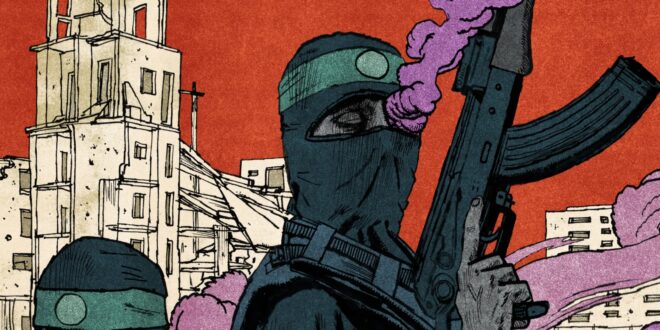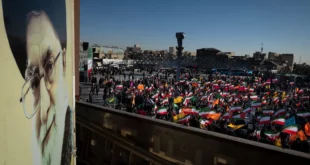A Strategy for Letting the Group Defeat Itself
The war in Gaza has settled into a mind-numbing pattern of violence, bloodshed, and death. And everyone is losing—except Hamas. When Israel invaded the territory last fall, its stated military objective was to destroy the terrorist group so that it could never again commit acts of barbarity like the ones it carried out during its October 7 attack. But although the war has culled Hamas’s ranks, it has also vastly increased support for the group—among Palestinians, throughout the Middle East, and even globally. And even though Israel was fully justified in taking military action after the attack, the way in which it has done so has caused immense damage to its own global standing and put intense strain on Israel’s relationship with the United States, its most important partner.
Israel’s overwhelming, unfocused military response has killed tens of thousands of Palestinian civilians, mainly women and children, even as Israelis taken hostage on October 7 languish or die in the custody of Hamas, Palestinian Islamic Jihad, and other Palestinian groups. By limiting the flow of humanitarian aid into Gaza, Israel has produced near-famine conditions in parts of the territory. Late last year, South Africa, with the eventual support of dozens of other countries, filed a complaint at the International Court of Justice accusing Israel of carrying out a genocide in Gaza. In May, the Biden administration halted some U.S. arms shipments to Israel, signaling its displeasure with Israeli plans to invade the southern Gazan city of Rafah, where more than a million civilians had taken refuge.
The Israeli war in Gaza has been a strategic disaster.
Worse yet, although Israel claims to have killed thousands of Hamas fighters, there is little evidence to suggest that the group’s ability to threaten Israel has been significantly compromised. In some respects, Israel’s response has even helped Hamas. A March 2024 opinion poll by the Palestinian Center for Policy and Survey Research showed support for Hamas among Gazans topping 50 percent, a 14-point rise since December 2023. It’s upsetting to see that the slaughter of Israeli civilians—including children and elderly people—could indirectly build sympathy for Hamas. As a nonstate actor that deliberately targets civilians with violence for symbolic and political ends, Hamas meets all the criteria for being considered a terrorist organization. The group is composed of self-serving, violent extremists who prioritize armed struggle over effective governance and the welfare of Palestinians. There is no question that eliminating Hamas would be good for Palestinians, Israel, the Middle East, and the United States.
But the Israeli government’s highly lethal response to the October 7 attack and seeming indifference to the death and suffering of Palestinian civilians has played into Hamas’s hands. Among the audiences that the group most wants to reach, including Palestinians in Gaza and the West Bank, Arab populations throughout the region, and young people in the West, the heinous deeds of October 7 have receded from view, replaced by images that support the Hamas narrative, in which Israel is the criminal aggressor and Hamas is the defender of innocent Palestinians.
Simply put, despite some tactical victories, the Israeli war in Gaza has been a strategic disaster. For Israel to defeat Hamas, it needs a better strategy, one informed by a deeper understanding of how terrorist groups generally end. Fortunately, history provides ample evidence on that subject. Over the course of decades of research, I have assembled a dataset of 457 terrorist campaigns and organizations, stretching back 100 years, and have identified six primary ways in which terrorist groups end. These pathways are not mutually exclusive: frequently, more than one dynamic is at work, and multiple factors play a role in the termination of a terrorist group. But Israel should pay close attention to one route in particular: groups that end not through military defeat, but through strategic failure. Since October 7, Israel has been trying to crush or repress Hamas out of existence, to little avail. A smarter strategy would be to figure out how to chip away at the group’s support and hasten its collapse.
RETURN OF THE REPRESSED
The least common pathway to termination is success; a small number of groups cease to exist because they achieve their goals. One familiar example is uMkhonto weSizwe, the military wing of the African National Congress in South Africa, which carried out attacks on civilians early in its campaign to end apartheid. Another is the Irgun, the Jewish militant group that employed terrorism in an effort to push the British out of Palestine, force many Arab communities to flee, and help lay the groundwork for the establishment of Israel.
But it is exceedingly rare for a terrorist group to achieve its core objectives: in the past century, only about five percent have done so. And Hamas is not likely to join that list. Israel is much stronger than Hamas in every military and economic dimension, and it has the support of the United States. The only way Hamas could succeed in achieving its goal of “the complete liberation of Palestine, from the river to the sea” would be if Israel so undermined its own unity and integrity that it destroyed itself.
A second way a terrorist group can end is by transforming into something else: a criminal network or an insurgency. Criminality and terrorism overlap, so that particular shift is more like moving along a spectrum than like morphing into something new as a group stops trying to catalyze political change in favor of exploiting the status quo for monetary gain. A shift to insurgency happens when a group mobilizes enough of the population that it can challenge the state for control of territory and resources. That, unfortunately, is a possible outcome in Gaza—and perhaps the West Bank and even Israel proper—if Israel maintains its current strategy.
A third way terrorist groups end is through successful military repression on the part of a state. That is the ending that Israel’s current campaign against Hamas hopes to bring about. Repression can succeed, although at enormous costs. Take, for example, Russia’s second campaign against separatists in Chechnya, which began in 1999 and continued for nearly a decade. Accurate figures are hard to come by, since Russian authorities prevented journalists from reporting on the conflict (and even targeted some who tried), but most independent sources have estimated that at least 25,000 civilians were killed and that hundreds of thousands were displaced. The bloodshed was massive and the destruction epic, but Russia did wipe out the main separatist groups, depopulating the region and paving the way for a pro-Russian government.
Similarly, in 2008–9, the Sri Lankan government set out to annihilate the Liberation Tigers of Tamil Eelam by trapping the group on a small strip of land in the northeastern region of the island country. The resulting operation killed tens of thousands of civilians, according to the United Nations. But it also eliminated the LTTE leadership, effectively ending the group and the broader civil war that had raged in Sri Lanka for nearly three decades.
Overall, however, military repression has a poor track record as a form of counterterrorism. It is difficult and costly to sustain and tends to work best when members of a terrorist group can be separated from the general population, a condition that is hard to create in most places. Repressive campaigns erode civil liberties and strain the fabric of the state. Scorched-earth tactics change the character of society and raise the question of what, precisely, the government is defending.
Consider, for example, Uruguay in the early 1960s. At the time, the country had a robust party system, an educated urban population, and an established liberal democratic tradition. But when the Tupamaros, a Marxist-Leninist group, carried out a series of assassinations, bank robberies, and kidnappings, the government unleashed the armed forces. By 1972, the military had eradicated the group. Even though the attacks had ended, the army then launched a coup, suspended the constitution, dissolved parliament, and established a military dictatorship that ruled the country until 1985. In their short campaign, the Tupamaros had carried out 13 bombings (with an unknown number of casualties), executed one hostage, and assassinated fewer than ten officials. The military regime, however, killed, maimed, or displaced thousands. The Tupamaros were gone, but ordinary Uruguayans remained the victims of violence, only now at the hands of the state, as the military government destroyed the country’s democracy.
In explaining their repressive approach in Gaza, Israeli leaders have argued that Hamas is similar to the Islamic State (also known as ISIS) and can be defeated in a similar way. It is true that, by 2017, a U.S.-led coalition had reconquered territory that ISIS seized in Iraq and Syria in 2014, reducing the group’s presence in those places. Yet ISIS has not ended. Instead, it has splintered into nine groups it calls “provinces,” which are based all over the world and still plot and sometimes successfully carry out bloody attacks. This past March, ISIS-K—the group’s “Khorasan province,” based in Afghanistan—attacked a concert hall near Moscow, killing more than 140 people. Moreover, unlike ISIS, which is an explicitly transnational movement, Hamas is an exclusively Palestinian group, focused on winning control of contested territory. Military force can degrade Hamas’s hold on Gaza, but without a political solution to the underlying territorial dispute, the group would soon reemerge in some form and resume targeting Israeli military forces and civilians.
Counterterrorism that is purely military rarely works.
Some might argue that the real trouble is not that Israel is relying on the wrong strategy but that it doesn’t have the right target. In this view, it is Iran, and not Hamas, that is the heart of the problem, since the theocratic regime in Tehran supports, arms, and funds the terrorist group. But any government that launches an attack against the state sponsor of a terrorist group risks getting itself into an even bigger mess. This past April, Israel and Iran engaged in an unprecedented series of tit-for-tat attacks that could have escalated into a full-blown war. But both countries eventually stepped back from the brink, and for now, Israel remains rightly focused on dealing with Hamas directly.
Ultimately, Israel’s lack of success in Gaza so far should come as no surprise: counterterrorism that is purely military rarely works and is especially difficult for a democracy to pull off. For one thing, it requires suppressing media coverage to a degree that is difficult to achieve in today’s global digital media landscape (although the Committee to Protect Journalists reports that more than 100 journalists and media workers have been killed in Gaza since the war began). Also, compared with other governments that have relied on military repression in fighting terrorists, many of which are authoritarian, Israel is somewhat more hemmed in by its own laws and policies and because it relies heavily on a patron—the United States—that criticizes the use of excessive force, opposes the commission of war crimes, and at least putatively conditions its military aid on lawful conduct.
OFF WITH THEIR HEADS
A fourth way that terrorist groups end is through decapitation: the arrest or killing of leaders. Direct Action, a radical left-wing French group, carried out a campaign of assassinations and bombings in the 1980s but ceased operations after the arrest of its principal leaders in 1987. In 1992, Abimael Guzmán, the leader of the far-left Peruvian terrorist militia the Shining Path, was arrested; violence immediately declined, the militants accepted a government amnesty, and the group fragmented into much smaller narco-criminal gangs over the next ten years. Aum Shinrikyo, a Japanese terrorist doomsday cult, changed its name and eventually renounced violence after its leader, Shoko Asahara, was arrested in 1995.
Groups that end through decapitation tend to be small, hierarchically structured, and characterized by a cult of personality, and they usually lack a viable succession plan. On average, they have been operating for less than ten years. Older, highly networked groups can reorganize and survive.
Hamas, then, is not a good candidate for a decapitation strategy. It is a highly networked organization that is almost 40 years old. If killing Hamas leaders could end the group, it would have happened long ago—and the Israelis have certainly tried. In 1996, Israeli security forces set off an explosive device inside a mobile phone used by Yahya Ayyash, a senior figure in Hamas and the group’s chief bomb maker; he died instantly. With the outbreak of the second intifada a few years later, the assassinations ramped up, and in 2004, Israel killed Hamas’s founder, Ahmed Yassin.
A 2006 study by the scholars Mohammed Hafez and Joseph Hatfield examined rates of Hamas violence before and after such assassinations and concluded that their impact was negligible. Subsequent studies have reached similar conclusions. Targeted killings have barely affected the group’s capabilities or intentions. Yet in the wake of October 7, the Israeli government reached for the tactic again. A few weeks after the attack, Prime Minister Benjamin Netanyahu told reporters that Israel would “assassinate all the leaders of Hamas, wherever they are.” Ronen Bar, the chief of Israel’s internal intelligence agency, the Shin Bet, told members of the Israeli parliament that Israel would kill Hamas leaders “in Gaza, in the West Bank, in Lebanon, in Turkey, in Qatar, everywhere.” Since last October, Israel has reported killing over 100 Hamas leaders, including some senior commanders in the group’s military wing.
But these assassinations, although degrading Hamas’s military strength in Gaza, have not affected the group’s long-term capabilities; over the decades, it has demonstrated an ability to replace key leaders. And in addition to yielding few tactical gains, this approach has created strategic costs. When killing a leader may prevent an imminent attack, it is justified self-defense. But endless targeted killings not publicly connected to specific operations lead many observers to see a state’s actions as morally equivalent to those of the terrorist group itself. That is especially true the wider the list of targets grows: consider, for example, an Israeli airstrike in Gaza in April that killed three sons and four grandchildren of the Qatar-based Hamas political leader Ismail Haniyeh, which allowed him to portray himself not as a terrorist mastermind but as a grieving father and grandfather.
THE TALKING CURE
Instead of trying to kill Hamas leaders, Israel might try negotiating with them on a long-term political solution. That idea would be anathema to most Israelis, of course. And no one familiar with the long history of failed negotiations between the Israelis and the Palestinians—not to mention the profound anger that both groups currently feel—would be foolish enough to recommend peace talks now.
But negotiation does represent a fifth way that terrorism can end. Think, for example, of Northern Ireland, where the 1998 Good Friday Agreement ended the Provisional Irish Republican Army’s decades-long campaign of terrorism. In 2016, the Revolutionary Armed Forces of Colombia entered into a complex agreement with the government and agreed to disarm and operate as a normal political party. Like Hamas, those groups had enthusiastically murdered civilians. Talking to them was difficult for officials, and accepting former members back into society was hard for the public, especially the group’s victims and their families. But the bloodshed stopped, and in the end, states gave up relatively little.
Negotiations are risky for terrorist groups because showing up at the bargaining table gives away useful intelligence and undercuts the narrative that there is no alternative but to engage in violence. Only about 18 percent of terrorist groups ever negotiate at all, and talks usually drag on while violence continues, just at a lower level. Groups that have been around a long time are more likely to negotiate; the average lifespan of a terrorist group is eight to ten years, but groups that negotiate tend to have been around for 20 to 25 years.
Of course, there must be something tangible to negotiate over, and the most successful negotiations with terrorist groups involve conflicts over territory as opposed to religion or ideology. But even in the absence of an agreement, serious talks can cause divides within terrorist groups, splitting those who seek a political settlement from those still wedded to fighting. (On the other hand, negotiations sometimes prove futile: before moving to wipe out the LTTE, the Sri Lankan government spent more than five years negotiating with the group in talks brokered by Norway.)
Negotiations may not seem a likely way for Hamas to end. For one thing, the group has a long history of scorning talks with Israel. In the 1990s, it would engage in spoiler attacks when it believed the peace process was making progress. And today, Hamas is more committed than ever to pursuing a variant of the so-called one-state solution that would involve obliterating the other side, as are some Israeli extremists.
Still, Hamas and Israel have conducted negotiations in the past, generally through intermediaries such as Qatar—including talks that led to a short cease-fire and an exchange of hostages and prisoners last November. It seems possible that external actors such as the United States, Egypt, Jordan, and Saudi Arabia might eventually find a way to push Israel and the Palestinians into a renewed diplomatic process aimed at creating a two-state solution. And it is possible to imagine Hamas, or at least some faction or remnant of the group, being involved in some way. Such negotiations would be long, fraught, and hamstrung by extremists on both sides. But merely announcing a process would have salutary effects. Indeed, it could even create the conditions for what might be the most likely way for Hamas’s terrorism to end: self-defeat.
THEIR OWN WORST ENEMIES
Most terrorist groups end in a sixth way: because they fail, either by collapsing in on themselves or by losing support. Groups that implode sometimes die out during generational shifts (the far-left Weather Underground in the United States from the 1960s to the 1980s), disintegrate into factions (remnants of the IRA after the Good Friday Agreement), break down over operational disagreements (the Front de Libération du Québec, a Canadian separatist group, in the early 1970s), or fracture over ideological differences (the communist Japanese Red Army in 2001).
Groups also fail because they lose popular support. Sometimes, that is because governments offer members a better alternative, such as amnesty or jobs. But by far the most important reason terrorist groups fail is that they miscalculate, especially by making targeting errors that stir revulsion among important constituencies. The Real IRA’s August 1998 bombing of Omagh, a small market town in Northern Ireland, killed 29 people, including a number of children. Widespread disgust at the attack unified disparate parts of society and solidified support for the Good Friday Agreement. Chechen separatists made a similar mistake in 2004 when they seized a school in Beslan, Russia, leading to the deaths of more than 300 people, including almost 200 children, and sparking a near-total collapse of support for the separatist cause inside Chechnya and throughout Europe. The following year, suicide bombers belonging to al Qaeda in Iraq (the forerunner of ISIS) attacked three hotels in Amman, Jordan, killing around 60 people. Opinion polls later showed that, in the aftermath, 65 percent of Jordanians changed their view of al Qaeda from positive to negative. (Historically, at least a third of al Qaeda’s victims have been Muslims, which is the main reason that the group has not become the popular movement that Osama bin Laden hoped it would be.)
Hamas has all the ingredients of a group that can fail. Most important, perhaps, is the fact that it is not popular. Shortly after the group took control of Gaza in 2007, Palestinian support for Hamas began to deteriorate. According to polling by the Pew Research Center, 62 percent of people in the Palestinian territories had a favorable view of Hamas in 2007. By 2014, only a third did. Khalil Shikaki, a Palestinian political scientist and pollster, has found that support for Hamas generally spikes during confrontations with Israel but then dissipates when the group fails to deliver positive change.
Israel’s excessive use of military force, however, has strengthened Hamas’s hold and aided the group’s propaganda about what happened on October 7. According to a poll that Shikaki conducted in March, 90 percent of Palestinians dismiss the idea that Hamas engaged in war crimes that day. Any revulsion that ordinary Gazans might have felt about what Hamas did in their name was likely overwhelmed by their horror over what Israel has done to their loved ones, homes, and cities.
Hamas has all the ingredients of a group that can fail.
Still, Hamas has fissures that could widen and even lead to its collapse. Its military and political leadership are not always in sync: according to The New York Times, the group’s Gaza-based military leader, Yahya Sinwar, launched the October 7 attacks with a handful of military commanders, keeping Hamas’s political leader, Haniyeh, in the dark until just a few hours before the operation began. Reporting by Reuters revealed that some Hamas leaders seemed shocked by the timing and scale of the attacks. The group also faces pressure and competition from Palestinian Islamic Jihad, which is smaller than Hamas but more closely aligned with Iran. And with much of Hamas’s organization in Gaza destroyed, other power structures, including clans and even criminal networks, could vie for control and undercut the group.
But the far more likely way that Hamas could fail is through popular backlash. Hamas rules Gaza through oppression, using arrests and torture to suppress dissent. Gazans widely loathe its internal General Security Service, which surveils and keeps files on people, stamps out protests, intimidates journalists, and tracks people accused of “immoral acts.” Since October 7, many Palestinians have expressed anger at Hamas for having misjudged the consequences of the attack—a serious targeting error that has indirectly led to the deaths of tens of thousands of Gazans. And suffering Palestinians are well aware that Hamas built an elaborate tunnel system to protect its leaders and fighters but did nothing to protect civilians.
To help Hamas fail, Israel should be doing everything in its power to give Palestinians in Gaza a sense that there is an alternative to Hamas and that a more hopeful future is possible. Instead of restricting humanitarian aid to a trickle, Israel should be providing it in massive quantities. Instead of merely destroying infrastructure and homes, Israel should also be sharing plans for rebuilding the territory in a post-Hamas future. Instead of carrying out collective punishment and hoping that Palestinians will eventually blame Hamas, Israel should be conveying that it sees a distinction between Hamas fighters and the vast majority of Gazans, who have nothing to do with the group and are themselves victims of its thuggish rule and reckless violence.
After decades of struggling with Hamas and months of fighting a massive, brutal war against it, Israel still seems unlikely to defeat the group. But it can still win—by helping Hamas defeat itself.
 Eurasia Press & News
Eurasia Press & News




